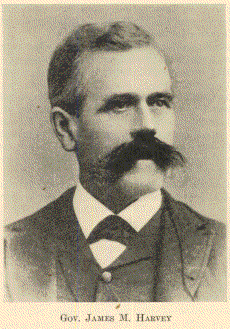| 1918 KANSAS AND KANSANS | Chapter 50 | Part 1 |
CHAPTER L
JAMES MADISON HARVEY

Gov. JAMES M. HARVEY
[Copy by Willard of Portrait in Library of Kansas State Historical Society]
James Madison Harvey, known in this day as "Old Honesty," was born in Monroe County, Virginia, September 21, 1833. He removed with his parents to Illinois, and received his education in the schools of that State. He later studied civil engineering. In 1854 he married Charlotte Cutter, of Adams County, Illinois. They came to Kansas in 1859, and located in Riley County.
Mr. Harvey became a firm Anti-slavery man, and fought bravely in the war. He served as Captain of Company G, Tenth Kansas Volunteer Infantry, and took part in the Battle of Prairie Grove. Afterwards, he was in a strenuous campaign through Missouri, Arkansas, and the Indian Territory. He was also chosen Colonel of a volunteer regiment sent to repel Price, in his raid. In 1865 Captain Harvey was mustered out with his regiment.
In the fall of 1865 he was elected to the Legislature, where he rendered valuable aid in untangling many of the problems left by the war, and the unsettled state of Kansas affairs.- He was re-elected by the Republicans against Thaddeus H. Walker, candidate of the Liberal Republicans. The Democrats put forward no candidate. In 1866 he was chosen to represent the Seventh District in the State Senate.
In the fall of 1869, he was elected as the Republican candidate for Governor. He was re-elected to that office in 1873. During his administration the State of Kansas advanced steadily along all lines of progress. Governor Harvey pretended to no great erudition - his was rather the homely knowledge and philosophy, the native shrewdness of the surveyor and farmer. But his unswerving honesty, his tenacity of purpose, his really superior mind, were all at the service of Kansas, and she profited richly by them.
The Legislature of 1869, under Governor Harvey, was the first body to meet in the State Capitol, after the completion of its first wing, the east one. Before, all the official business had been conducted in a small row of buildings on Kansas Avenue, known as "State Row."
Indian troubles were still rife, at this time, though not so serious as during the administration of Governor Crawford. The Indians harried the border, entering at the northwest. Militia, sent to the Republican, Saline and Solomon valleys, together with the presence of the United States troops, kept the Indians fairly within bounds.
The cattle trade grew by leaps and bounds, at this time, and the "cowboy" and the "Longhorn," were thick on the Kansas prairies. Also, at this time, the state received a liberal contribution of the worst elements of the older statesmen and women, eager to prey on the rich and reckless cowmen. This it required stern measures to check. Sheriffs and vigilance committees were kept busy by the disorder and violence rife in the western towns. Saloons, dancehalls, and gambling dens ran wide open for the benefit of the cowboy. But law and order gradually grew, and prosperity increased. The shipments of cattle at Wichita and Dodge City seldom were less than 200,000 head a year.
In March, 1869, the first train on the Atchison, Topeka and Santa Fe Railroad reached Topeka, and on the first of September, 1870, the Union Pacific Railroad reached Denver. This, of course, brought immense bands of emigrants to Kansas. In 1872, Kansas cast a larger vote than any New England state, excepting Massachusetts. Under the census of 1870, Kansas became entitled to three Representatives in Congress. Land companies all over the world, advertised Kansas. Her advantages to the new settler were described in many languages. The Kansas Pacific Railroad also worked along this line, and brought immense numbers of foreigners to Kansas. These became good, steady citizens, and are today among the foremost farmers and tradesmen of the State.
The emigrants were settled in colonies, and many quaint old-world customs and legends were transplanted to Kansas, and are still preserved intact on the prairies. Swedish, Scotch, English, and Welsh were the leading colonists of this time.
During the administration of Governor Harvey, the Grand Duke Alexis, of Russia, with his suite, made their celebrated exploring and hunting trip over the Kansas plains. They were received in Topeka by Governor Harvey, and the Legislature. Some old people of to-day can recall the "amazing splendor" of that occasion.
In 1870, the Labor Party organized. It held its first state convention in September of that year. A platform was determined on. Two of the "planks" were: two thousand dollars exempt from taxation, and the natural right to land.
At this time, the farmers of Kansas were beginning to feel keenly the need of co-operation and protection. With the growing of agriculture and trade, came the demand for system and advice. In consequence of this feeling, came the demand for a grange, which was accordingly organized, in 1872. Many thousands of farmers joined the organization.
Governor Harvey died, April 15, 1895. He was survived by four daughters and two sons.
Kansas sincerely mourned the honest, far-seeing man who had given so freely of his life to her service. And she is far-richer for his steady, kind guidance and help, and his unassuming upright life.
| 1918 Kansas and Kansans | Previous Section | Next Section |
A Standard History of Kansas and Kansans , written and compiled by William E. Connelley, transcribed by Carolyn Ward, 1998.
